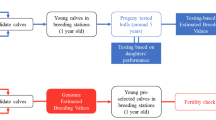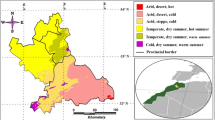Summary
In order to clarify the question of the reduction in improving effect of A.I.bulls in relation to the genetic trend of the population, the authors have carried out two model calculations: a) This one assumed different genetic progress as well as different improving effects of bulls. The duration and extent of improving effect have been examined. b) The data on an US-Holstein-Friesian elite population was processed to determine changes in improving effect during a period of 10 years, assuming 1 per cent genetic gain per year. Ten per cent of this elite population were chosen and examined as a ‘nucleus population’.
Conclusions are as follows: 1. In female populations representing continuous and considerable genetic progress, even bulls of excellent genetic merit can assure improvement for only a few years. 2. The improving effect may be referred to a definite population only if the progeny test results are directly related to the average of the population, or if these can be adjusted properly. 3. A ‘nucleus population’, selected and maintained by high selection pressure, could have such a great genetic superiority that progress is assured for a long time in the ‘population with high breeding value’. 4. A significant genetic advance has to be achieved, maintained and utilized in the sire-producing mating category. This requires reasonable rationalization of selection and mating, utilizing international gene-resources and continuous control of the breeding value of sires in the populations.
Similar content being viewed by others
Literature
Akahori, M.; Mitsumoto, T. 1977: Approaches to breeding system affecting genetic improvement in dairy cattle populations. Res. Bull. Obihiro University 1 (3)
Averdunk, G. (1975): Die Berücksichtigung des genetischen Trends in der Zuchtwertschätzung von Besamungsbullen. pp. 137–140. Hannover: Tierzüchter
Dohy, J. (1979): Mezsdunarodnoe szotrudnicsesztvo v oblaszti szkotovodsztva International cooperation in the field of cattle breeding. Mezsdunarodnij Szel'szkohozjajsztvennüj Zsurnal, Moszkva Intern. Agric. J. Moscow No. 4, 63–66
Hinks, C.J. (1978): The use of centralised breeding schemes in dairy cattle improvement. Anim. Breed. Abstr. No. 6 291–298
Lindström, U. (1969): Genetic change in milk yield and fat percentage in artificially bred populations of Finnish dairy cattle. Acta Agralia Fennica, No. 114, Agric. Res. Centre, Tikkurila (Finland)
Robertson, A. (1979): A review of A.I. and dairy cattle improvement. Br. Cattle Breeders' Club Winter Conf.
Skjervold, H. (1974): Introduction to a plenary session on dairy cattle breeding. 1st World Congress on Genetics Applied to Livestock Production, Madrid 1, 523–531
Van Vleck, L.D. (1977): Theoretical and actual genetic progress in dairy cattle. Proc. Int. Conference on Quantitative Genetics 543–567
Author information
Authors and Affiliations
Additional information
Communicated by L. Alföldi
Rights and permissions
About this article
Cite this article
Dohy, J., Boda, I. & Kovách, Á. Data on the reduction in improving effect of A.I. Bulls in relation to the genetic trend of the population. Theoret. Appl. Genetics 58, 1–4 (1980). https://doi.org/10.1007/BF00264658
Received:
Issue Date:
DOI: https://doi.org/10.1007/BF00264658




